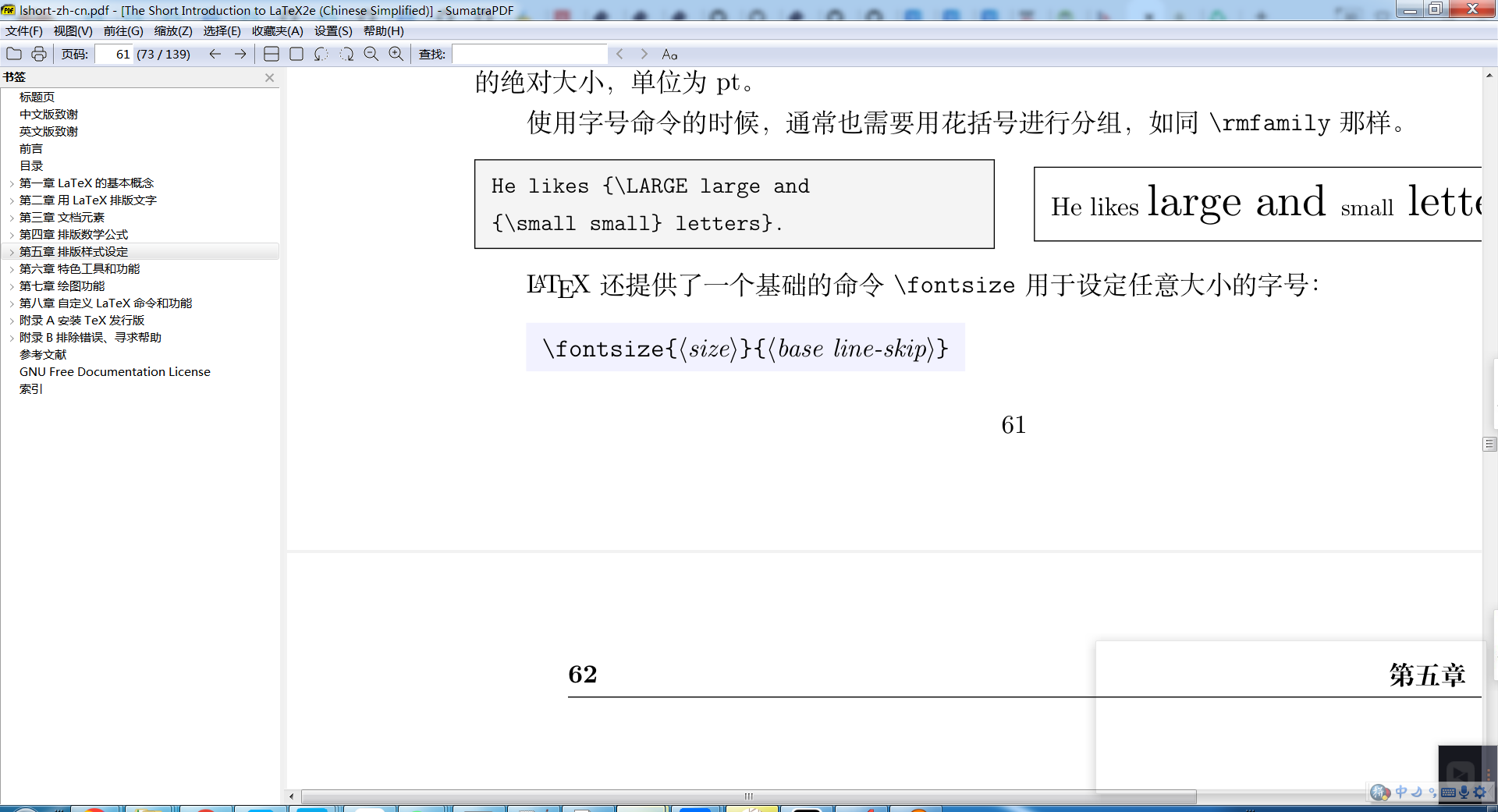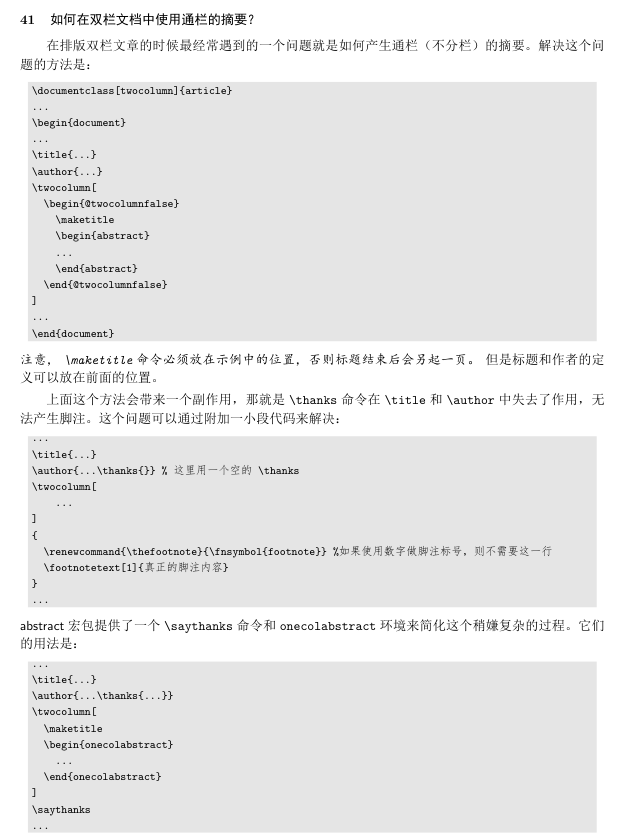那个label 就是中文名字,看看 cfg 文件里有没有定义。如果没有加上去就好了。
\def\CAST@label@abstract{摘要}看看
那个label 就是中文名字,看看 cfg 文件里有没有定义。如果没有加上去就好了。
\def\CAST@label@abstract{摘要}看看
可以看看 lshort-zh-cn 里面的定义:
%
% 命令和环境的写法
%
\DeclareRobustCommand*\cmd[1]{\texttt{\char`\\#1}}
\DeclareRobustCommand\cs[1]{\texttt{\char`\\#1}}
\def\crcmd{\cmd{\char`\\}}
\DeclareRobustCommand*\env[1]{\texttt{#1}}
\DeclareRobustCommand*\pkg[1]{\textsf{#1}}
\DeclareRobustCommand*\cls[1]{\textsf{#1}}
\DeclareRobustCommand*\marg{\@ifstar\@marg\@margmeta}
\DeclareRobustCommand*\oarg{\@ifstar\@oarg\@oargmeta}
\DeclareRobustCommand*\Arg[1]{\@meta{#1}}
\def\@oarg#1{\textcolor{gray}{\texttt{[#1]}}}
\def\@oargmeta#1{\@oarg{\@meta{#1}}}
\def\@marg#1{\texttt{\{#1\}}}
\def\@margmeta#1{\@marg{\@meta{#1}}}
\def\@meta#1{$\m@th\langle$\textnormal{\textit{#1}}$\m@th\rangle$}
%
% 命令和环境的索引
%
\def\pkgindex#1{\@for\pkgname:=#1\do{\index{\pkgname @\pkg{\pkgname} 宏包}}}
\def\clsindex#1{\@for\clsname:=#1\do{\index{\clsname @\cls{\clsname} 文档类}}}
\def\cmdindex{\@ifnextchar[{\pkgcmdindex}{\ltxcmdindex}}
\def\envindex{\@ifnextchar[{\pkgenvindex}{\ltxenvindex}}
\def\ltxcmdindex#1{\@for\@ltxcmd:=#1\do{\index{\@ltxcmd @\cmd{\@ltxcmd}}}}
\def\ltxenvindex#1{\@for\@ltxenv:=#1\do{\index{\@ltxenv @\env{\@ltxenv} 环境}}}
\def\pkgcmdindex[#1]#2{\@for\@pkgcmd:=#2\do{\index{\@pkgcmd @\cmd{\@pkgcmd} (\pkg{#1})}}}
\def\pkgenvindex[#1]#2{\@for\@pkgenv:=#2\do{\index{\@pkgenv @\env{\@pkgenv} 环境 (\pkg{#1})}}}使用的时候是:\cmd{fontsize}\marg{size}\marg{base line-skip}
效果:

要看具体的代码,flushend 需要加一个命令的。
具体要什么内容显示?
图片 可以复制粘贴到编辑框,自动上传的。
实际就是基本的 markdown 语法,我们网站早就支持了。选中一段代码,点击代码按钮可以自动加,也可以在文本区直接使用 md 命令即可。
目录可以分栏排的,如果一个演讲还需要两页的目录,这太吓人了。
比如:
\begin{frame}
\begin{multicols}{2}
\tableofcontents
\end{multicols}
\end{frame}后面的子节也需要可以加:
\AtBeginSubsection[]
{
\begin{frame}<beamer>
\begin{multicols}{2}
\tableofcontents[currentsection,hideothersubsections]
\end{multicols}
\end{frame}
}这是你自己写的模板?还是原来就这样?
没必要这样写的,table 就是默认放在后一页的顶部的,你是双栏里加单栏信息,没必要这样放的呀。
单元格自身就是不能跨页的。
是不是你的版本问题,下个最新的测试下。
没有有价值的信息,这样的提问,完全靠猜。
多行公式肯定有差别,这种情况没啥区别,另外 label 最好是英文。
简单一点就是在最后的可选参数里加一下:
\titleformat{\chapter}[block]
{\normalfont\ChapterFont\color{myblueii}}
{\tcbset{colframe=mybluei, boxrule=0.8pt, left=0pt, right=0pt, top=0pt, bottom=0pt}\hskip 0.25em\mbox{\tcbox[ boxsep=12pt, colback=mybluei, tcbox raise = -10pt]{\color{white}\bfseries\fontsize{65}{65}\selectfont\thechapter}}}
{0.5 em}
{#1\vskip0.6ex\endgraf\titlerule[1ex]}[\vskip-3em]在 bst 里搜索 format.name 然后参考 https://www.latexstudio.net/archives/11052.html
自己研究下,会搞得定的。
问 Undefined control sequence \begin{abstract}